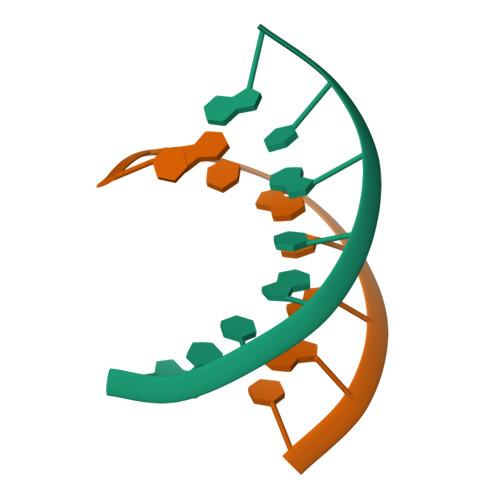Structure of a DNA:RNA Hybrid Duplex. Why Rnase H Does not Cleave Pure RNA
Fedoroff, O.Y., Salazar, M., Reid, B.R.(1993) J Mol Biology 233: 509-523
- PubMed: 8411159
- DOI: https://doi.org/10.1006/jmbi.1993.1528
- Primary Citation of Related Structures:
124D - PubMed Abstract:
The solution structure of the DNA:RNA hybrid duplex d(GTCACATG):r(caugugac) has been determined by means of two-dimensional nuclear Overhauser effect (2D-NOE) spectra, restrained molecular dynamics and full-relaxation matrix stimulation of the 2D-NOE spectra. The DNA:RNA hybrid duplex assumes neither an A-form nor a B-form structure in solution, but an intermediate heteromerous duplex structure. The sugars of the RNA strand have a normal N-type C3'-endo conformation, but the DNA strand sugars have neither N-type nor S-type conformations; instead, they have an unexpected intermediate O4'-endo conformation. The negative x-displacement, as well as the small rise and positive inclination of the base-pairs, resembles A-form morphology but the minor groove width is intermediate between that of A-form and B-form duplexes. Both the DNA and RNA strands show prominent sequence-dependent variations in their helical parameters. Combined analysis of NOE and J-coupling data indicates that the DNA sugars are not in a dynamical two-state equilibrium. The detailed three-dimensional structure of this DNA:RNA hybrid molecule leads to a proposed model for its interaction with RNase H. Several specific structural features of the enzyme complexed with the hybrid duplex appear to explain the mechanism whereby RNase H discriminates between DNA:RNA hybrid duplexes and pure RNA:RNA duplexes.
Organizational Affiliation:
Department of Chemistry, University of Washington, Seattle 98195.

















